16. The introduction of salt lakes in Tibet
Tibet Plateau is one of the most densely populated areas of salt lakes in our country, the highest elevation area of salt lakes, the quantity and types of salt lakes is the most. In this area, there are about 500 salt lakes and the total area is 8225 km2.

Zhacang-Chaka Salt Lake, Tibet
In these lakes, there are 234 lakes that their area is more than 1 km2, the total area is 8150.18 km2. in the north of Tibet Plateau, there are 218 salt lakes and this area is the main salt lake area. in the south of Tibet Plateau, there are 14 salt lakes, and in the east of Tibet Plateau only have 2 salt lakes.
In Tibet, there are 39 salt lakes and the area of these lakes is more than 50 km2, the total area is 4100 km2. the elevation of lakes is more than 4500 m, and some lakes is more than 5000 m. the highest salt lake is Qingche lake and the elevation is more than 5100. the main salt lakes include Bange-Cuo, Zhacang-Chaka, Xiao-Chaka and so on.
In Tibet Plateau, there are 3 salt lake areas, including the north of Tibet Plateau, the east of Tibet Plateau and the south of Tibet Plateau.
In Tibet Plateau, the brine is high salinity,basic, and the pH value is 7-9.3, the relative density is 1.030-1.329, the salinity is 50-350 g/L and the highest salinity is 365 g/L. the main elements include Na, K, Mg, Ca, but B, Li, Rb, Cs also have higher quantity in brine. There are more than 40 minerals in salt deposits , including 16 Carbonate minerals, 8 borates, 4 chloride minerals and 12 sulfates. The main salt deposits have halite, mirabilite, lancasterite and borate.
17. The introduction of salt lakes in Inner Mongolia
There are 375 salt lakes and the total areas is 1441 km2 in Inner Mongolia.The main distribution region of salt lakes are Hulun Buir, Siklingelei, Erdos and Alxa. The area of lakes is small in Inner Mongolia. There are only 2 salt lakes their area are more than 100 km2, they are Gashunnuoer and Jartai.
In Inner Mongolia, there are 4 salt lake areas, including Hulun Buir, Siklingelei-Ulan Qab, Erdos and Alxa.
The main types of lake are carbonate and sulfate, and no chloride lake. The brine have surface and intercrystalline, and intercrystalline brine is main. The main compositions are Na, Cl, SO4 and CO3. the salt deposits have 23 species, including 11 carbonate minerals, 2 chloride minerals and 10 sulfates.

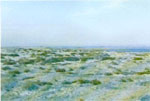
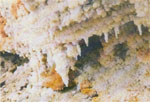
Salt Layer of Jilantai Salt Lake
18. Salt lakes in Xinjiang
There are 112 salt lakes and the total area is 10789 km2. In Altaic, Tianshan Mountains, Kunlun-Aerhchin Mountains basin, there are 81 salt lakes and this area is the main distribution region. In Dzungarian andTarimBasin, there are 31 salt lakes.
In Xinjiang, there are 5 salt lake areas, including Zhunge--Altaic basin, Zhunger Basin, Tianshan Mountains basin, Dzungarian andTarimBasin and Kunlun-Aerhchin Mountains basin.
Most lakes in Xinjiang are dry salt lakes. Only 17 lakes have surface brine. The area of Lop Noris 5500 km2, is the biggest dry salt lake in Xinjiang. The average elevation of salt lakes in Xinjiang is 1429.23 m. the elevation of whale lake is 4708 m, but the elevation of Aydingkol is -155, the phenomenon is very rare in the world.
The main type of salt lake is sulfate. The minor type are carbonate and chloride. The minerals have 38 species. nitratemineral, especially KNO3 is rare in the world.

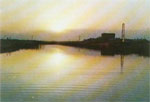
Aydingkol salt lake Ebinur Lake
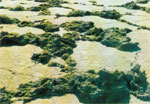

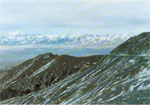
19. The characteristics of salt lake resources in China
The characteristics of Chinese salt lake resources can be summarized as follows: multiple, large, rich and complete.
The so-called "multiple" refers to many kinds of mineral resources in the large quantity salt lakes in China. There are salt lakes everywhere in Xinjiang and Tibet Autonomous Region and Qaidan Basin in Qinghai is called to be “the salty world”. Solid mineral resources in salt lakes are very rich in raw materials and the types of minerals are complete. Among them, the halite, mirabilite, gypsum, sal ammoniac soda, borate, magnesium salt, sylvite, strontium salt and so on can be exploited on a large scale. Besides there are many types of deposits in the liquid mineral resources in salt lakes, such as strontium, magnesium, lithium, rubidium, cesium, potassium, boron, bromine, iodine, uranium and so on.
The so-called " large " refers to the large area and reserves of certain salts mineral resource in some of Salt Lake in China. For example, Qiadan Salt Lake in Qaidan Basin, with a total area of over 5800 square km, 5 times larger than that of the Dead Sea in Western Asia, and 1.6 times larger than that of American Utah's big salt. Moreover, there are 10 billion tons of the chloride (rock salt, magnesium chloride, lithium chloride) reserves in Qiadan Salt Lake.
The so-called "rich" refers to the high ore-grade of (0)
() some certain minerals in Salt Lake. For example, in some of our Salt Lake, boron content can be as high as 1.4g/L, lithium 2g/L rubidium, cesium and uranium as high as dozens of mg/L.
The so-called "complete" refers to the complete type of salt lake deposits. In salt lake area of our country, the ore types of the carbonate deposits like Trona deposits, magnesite deposits etc., the sulfate deposits like Glauber's salt deposits, gypsum deposits, lapis lazuli etc., chloride deposits like halite ore deposit, the sylvinite ore deposit, the carnallite ore deposit, the bischofite ore deposit etc., and borate ore deposit like the natural borax, the ulexite, pinnoite, inderite, kurnakovite and water-boracite ore deposit etc. are very complete.
20. How many types of mineral resources in Chinese Salt Lake?
There are five types of mineral resources in Chinese Salt Lake: carbonate, sulfate, chloride, borate, brine resources.
Among the types of mineral resources in Chinese Salt Lake, the Trona deposits and magnesite deposits are the carbonat with industrial significance; the Glauber's salt deposits, gypsum deposits, lapis lazuli are the sulfate ones; the halite ore deposit, the carnallite ore deposit, the magnesium chloride and calcium chloride resources are the chloride ones; the borax (Na2B4O7·10H2O), the rasorite (Na2B4O7·4H2O), the ulexite (CaNaB5O9·8H2O), the pinnoite (MgB2O4·3H2O) and the kurnakovite (Mg2B6O11·15H2O) are the borate ones.
The salt of resources Salt Lake can be divided into three types: boron-lithium brine deposits of carbonate, boron-lithium brine deposits of sulfate and potassium-magnesium brine deposits of carbonate.